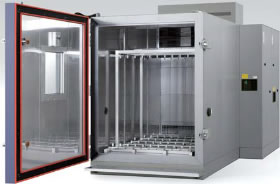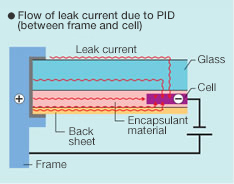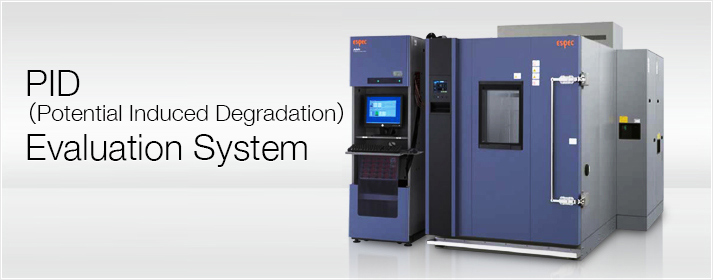PID creates an output drop in PV modules
Automatically measures leak current resulting from PID in high temperature and humidity environments
Potential Induced Degradation (PID), which occurs in solar power systems, is a degradation phenomenon caused by a leak current due to a large potential difference occurring in the PV module frame and module circuit. PID is believed to be one factor for lowering the output of solar power systems, and it is said that humidity promotes this phenomenon.
ESPEC's PID Evaluation System measures the leak current by applying high-voltage current in a high temperature and humidity environment with high accuracy and excellent reproducibility so as to accurately evaluate this PID phenomenon. This system is essential in evaluating PV module degradation.


- Features
-
- Temperature and humidity chamber and voltage application insulation resistance measurement system
This system comprises a temperature and humidity chamber for testing safety and easy setting of the PV module and a high-voltage application insulation resistance measurement system for measuring the leak current between the frame and cell and for controlling the entire system.
You can choose the temperature and humidity chamber according to the module size. - Measure Leakage current of 10 PV modules at the same time
Apply a voltage up to ±1.5 kV to each of 10 PV modules (max. size: 1,800 × 1,500 × 50 mm), and measure and record the leak current. It comes with a temperature and humidity chamber (inside chamber) and a rack that uses a resin insulation material and can be installed in an electrically insulated condition. - Independently grounded to prevent high-voltage electrostatic charge
The plate on the inside of the door of the temperature and humidity chamber, the interior, and the electrical components on the transformer secondary side are each wired to the grounding terminal to prevent electrical shock accidents. - Various safety specifications to support high-voltage tests
The door has a locking mechanism to prevent accidental opening during high-voltage tests, and an interlock forcibly stops high-voltage application when the door is open.
- Temperature and humidity chamber and voltage application insulation resistance measurement system
- Functions
-
- Fault determination function
A leak current value is set in advance to determine a fault, and when that value is exceeded, high-voltage application to the PV module is stopped. - High-speed leak detection function
Leak currents are detected with a measurement speed of 20 msec.
Sudden fluctuations in leak current are also detected. - Slow voltage application control function
To control the PV module load at high-voltage increases, the voltage is gradually increased, thereby decreasing the load.
- Fault determination function
- Specifications (example)
-
Temperature and humidity chamber
FMS-4050 Temperature and humidity control range ±1.5°C / ±5%rh Temperature and humidity distribution -40°C to +100°C / 40% to 95%rh Inside dimensions W1200 × H1650 × D2000mm Outside dimensions W1720 × H2370 × D3300mm * We can provide a temperature and humidity chamber to suit your needs depending on the number of modules and their size.
-
Measurement system part
AMIK-2000 Application voltage range ±10V to ±1500V
(Polarity can be changed using the relay box part)Leak current measurement range ±0.1pA to ±1mA
(The display is the absolute value display of the positive polarity)High-speed leak detection function Range ±4μA to 100μA
Detection speed Approx. 20 msecNumber of channels 20ch Outside dimensions W530 × H1750 × D1040mm
(Excluding relay box part)
- Laboratory testing services
-
PID evaluation test
PID evaluation tests can be contracted at ESPEC testing laboratory.
Please contact us for more information.
Recommended products for customers viewing this product






